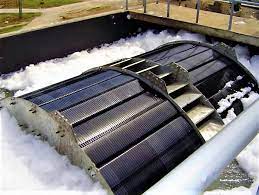In order to understand this section well, a closer look at this sketch and others are quite necessary.

Fig.: Rotating Biological Contactor
Biological Contactor (RBC)
The treated effluent clarifier/settler is not included in the diagram. A rotating biological contactor or RBC is a biological treatment process used in the treatment of waste-water following primary treatment (Grady and Daigger et al, 1998).
The primary treatment process removes the grit and other solids through a screening process followed by a period of settlement. The RBC process involves allowing the waste- water to come in contact with a biological medium in order to remove pollutants in the waste-water before discharge of the treated waste-water to the environment, usually a body of water (river, lake or ocean).
A rotating biological contactor is a type of secondary treatment process. It consists of a series of closely spaced, parallel discs mounted on a rotating shaft which is supported just above the surface of the waste water.
Read Also : Meaning and Factors affecting Sedimentation in Waste-water Treatment
Micro-organisms grow on the surface of the discs where biological degradation of the waste-water pollutants takes place.
Rotating Biological Contactors (RBCs) are mechanical secondary treatment systems, which are robust and capable of withstanding surges in organic load. RBCs were first installed in Germany in 1960 and have since been developed and refined into a reliable operating unit.
The rotating disks support the growth of bacteria and micro-organisms present in the sewage, which break down and stabilize organic pollutants. To be successful, micro-organisms need both oxygen to live and food to grow. Oxygen is obtained from the atmosphere as the disks rotate.
As the micro-organisms grow, they build up on the media until they are sloughed off due to shear forces provided by the rotating discs in the sewage.
Effluent from the RBC is then passed through final clarifiers where the micro-organisms in suspension settle as sludge. The sludge is withdrawn from the clarifier for further treatment.
A functionally similar biological filtering system has become popular as part of home aquarium filtration and purification. The aquarium water is drawn up out of the tank and then cascaded over a freely spinning corrugated fiber-mesh wheel before passing through a media filter and back into the aquarium.
The spinning mesh wheel develops a biofilm coating of micro-organisms that feed on the suspended wastes in the aquarium water and are also exposed to the atmosphere as the wheel rotates.
This is especially good at removing waste urea and ammonia urinated into the aquarium water by the fish and other animals.

Fig.: Operation o fRBC (Beychok, 1967).
The rotating packs of disks (known as the media) are contained in a tank or trough and rotate at between 2 and 5 revolutions per minute. Commonly used plastics for the media are polythene, PVC and expanded polystyrene.
The shaft is aligned with the flow of waste-water so that the discs rotate at right angles to the flow with several packs usually combined to make up a treatment train. About 40% of the disc area is immersed in the waste-water.
Biological growth is attached to the surface of the disc and forms a slime layer. The discs contact the waste-water with the atmospheric air for oxidation as it rotates. The rotation helps to slough off excess solids.
The disc system can be staged in series to obtain nearly any detention time or degree of removal required. Since the systems are staged, the culture of the later stages can be acclimated to the slowly degraded materials.
The discs consist of plastic sheets ranging from 2 to 4 m in diameter and are up to 10 mm thick. Several modules may be arranged in parallel and/or in series to meet the flow and treatment requirements.
The discs are submerged in waste water to about 40% of their diameter. Approximately 95% of the surface area is thus alternately submerged in waste water and then exposed to the atmosphere above the liquid.
Read Also: Industrial Wastewater Treatment Procedure
Carbonaceous substrate is removed in the initial stage of RBC. Carbon conversion may be completed in the first stage of a series of modules, with nitrification being completed after the 5th stage. Most design of RBC systems will include a minimum of 4 or 5 modules in series to obtain nitrification of waste water.
Biofilms, which are biological growths that become attached to the discs, assimilate the organic materials in the waste-water. Aeration is provided by the rotating action, which exposes the media to the air after contacting them with the waste-water, facilitating the degradation of the pollutants being removed.
The degree of waste-water treatment is related to the amount of media surface area and the quality and volume of the inflowing waste-water.
Secondary Clarification
Secondary clarifiers following RBCs are identical in design to conventional humus tanks, as used downstream of trickling filters.
Sludge is generally removed daily, or pumped automatically to the primary settlement tank for co-settlement. Regular sludge removal reduces the risk of anaerobic conditions from developing within the sludge, with subsequent sludge flotation due to the release of gases.

